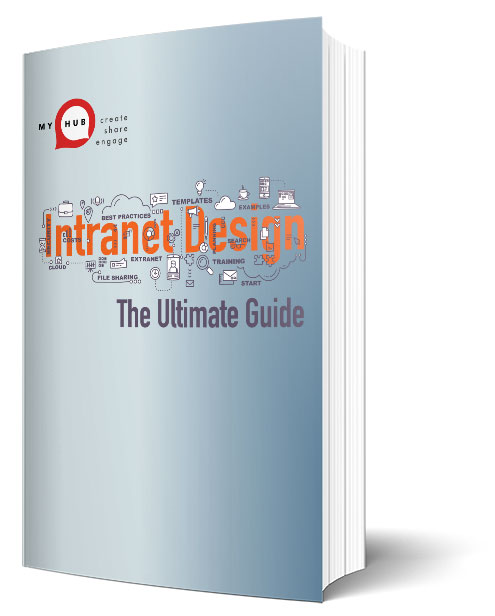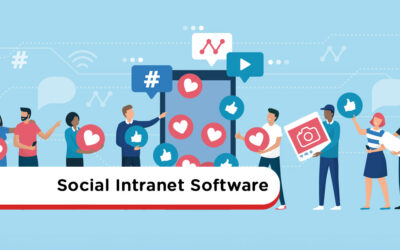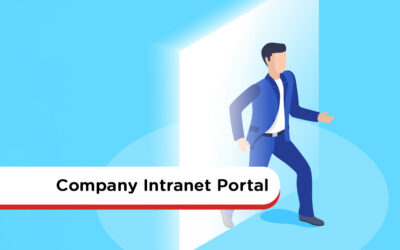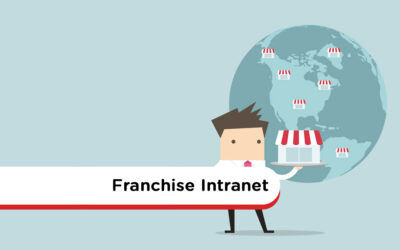The Intranet Design Guide
Not sure where to get started in designing your intranet?
Check out our easy step-by-step guide below.
Let us guide you through the process.

Intranet Design Made Simple
Deciding to go ahead with an intranet was the easy part, right? After all, whether it’s improved communications, more streamlined processes, or easier access to information, the intranet ticks all the boxes.
However, designing your intranet can be a daunting task.
There are many decisions to be made around the type of intranet, hosting options, organization, structure, plus content, and design. With so much to think about, it can be tough to get started.
And if technology isn’t really your thing, it can be even harder to kick-start your intranet. That’s where this intranet design guide comes into play.
So, if widget, cache, and malware sound like another language, then this guide is for you! Written in simple-to-understand and jargon-free terms, the design guide is non-technical. And where technical language is unavoidable, we clearly define what we mean.
This guide will show you that designing an intranet is a simple task. In fact, it’s so easy, you won’t need IT backup or a college degree in computers!
Click here to download this guide in PDF format
Step-By-Step Intranet Design Support
The guide is a comprehensive resource, covering everything you need to know about intranets. We provide helpful insights at every stage, from different intranet types and hosting options to security and training.
And we also look at all the latest intranet design best practices. This resource includes lots of practical examples and visuals that will excite and inspire you.
What’s Included In This Intranet Design Guide
Who Should Read This Guide
The design guide is an essential resource for anyone planning to implement a new intranet. It’s also required reading if you are looking to revitalize, revamp, or refresh an existing intranet.
Perhaps you are in the market for an intranet provider to help you realize your vision. The design guide can help you make a winning selection.
Written for the non-technical person, this resource will also support HR or Marketing staff tasked with implementing an intranet.
Why Intranet Design Is So Important
Before we move on, it’s essential to understand why intranet design is so important.
Your intranet’s overall look and feel has the power to grab users’ attention and draw them in. It can spark creativity and foster collaboration. It can connect employees and turn the everyday task into something engaging and fun.
However, the stakes are high. A poorly designed intranet will have the opposite effect. A confusing, overloaded, and ugly intranet will see staff switch off. It’s a wasted opportunity as well as investment.
With so much to lose, getting your intranet design right has to be a priority.
No Two Intranets Are Alike
When it comes to design, there is no one-size-fits-all intranet solution. Sure, there will be similarities. It could be layout, functionality, or scope. However, every organization is different, and so too is their intranet.
Furthermore, staff members will use the intranet differently depending on their job roles and team functions.
Employees use the intranet mainly to source information or collaborate with colleagues. Managers, however, use the intranet to engage workers with targeted communications.
Your intranet design needs to satisfy all the varying needs of employees.
And it also needs to meet the challenges of the modern digital workplace.
The global Covid-19 pandemic has fast-tracked the shift towards remote working. Companies have to pivot and rethink how they engage with their workforce in today’s rapidly changing environment.
And they need to ensure employees have the tools available to remain productive even when working from home.
A mobile intranet is a minimum requirement. In fact, it’s not so much a requirement as an expectation. Whether staff are on the go or working from home, they expect to continue working.
Versatile and flexible, the intranet is capable of meeting these competing demands. And your intranet design should make this vision a reality.
Intranet Templates Make Design Easy
And if you are pushed for time, then intranet design templates could be the perfect solution. This guide takes you through all you need to know.
In short, intranet templates come with in-built coding plus a basic design and graphics. The setup wizard makes it quick and easy to implement your customized intranet. Upload your logo, branding, and corporate colors to really put your company stamp on the intranet. And the good news is the intranet provider has already extensively tested the functionality. And that’s one less major headache for you to worry about.
Therefore, design templates are a popular choice if you need to get your intranet up and running quickly.
Let Us Guide You
Use this guide to make your intranet deployment a smoother and quicker process.
Essential reading for those starting to deploy an intranet, this resource will also help businesses looking to revamp an existing intranet.
Either way, we understand the challenges that are involved. And you get the benefit of our experience as we guide you through the process from beginning to end.
So, let’s get started.
Intranet Design Infographic
If you would like an overview of our intranet design guide, we have created a PDF infographic file summarizing the main points available here.
Further Reading
This further reading list will be an invaluable resource as it takes you through everything you need to know. We give you the benefit of our considerable experience in developing intranets and provide simple, easy-to-follow explanations, insights and advice.
Use this list to explore the latest intranet design best practice principles. Find out how pre-built intranet templates could well be the solution every time-pressed business owner is looking for. Discover how to ensure your intranet design is mobile friendly and optimized for use on smartphones and tablets. And learn about how to make your intranet interactive and fun so that users readily engage with the platform making for a more efficient and effective workplace.
These are just some of the insights available in this category so why not have a browse or use the search functionality to explore more about intranet design. With our comprehensive knowledge bank, you’ll soon discover that designing an intranet isn’t the mammoth task that perhaps you first thought it was.
Social Intranet Software – Social Media Networking For Employees
A social intranet transforms the traditional internal network into a vibrant collaboration hub. By incorporating features like instant messaging, activity walls, forums, and personalized employee profiles, it bridges the communication gap between remote, hybrid, and in-office teams—making interaction seamless and inclusive.
These platforms enable meaningful engagement through recognition tools, giving employees a voice at all levels—from top-down announcements to peer shoutouts and peer-to-peer thanks. The benefits extend to faster decision-making facilitated by real-time messaging (with 66% of users resolving queries quickly and 75% seeing reduced calls and emails), efficient knowledge sharing, and speedy onboarding via virtual channels.
Social intranets also strengthen company culture by letting employees share personal interests through rich user profiles—fostering connections even when teams are spread across locations. Their impact ranges from improved morale and reduced absenteeism to smoother onboarding and problem-solving, especially within distributed teams.
Sharing Ideas – How To Encourage Staff To Share Ideas
Encouraging employees to share ideas, knowledge, and insights is essential for nurturing innovation and improving business performance. Modern intranet platforms facilitate a smooth idea-sharing experience by being accessible to all staff—as well as to freelancers, contractors, and remote workers—at any time. These systems provide a structured environment where contributions thrive.
Successful idea-sharing involves more than just collecting suggestions—it requires the right tools and culture. Intranet-based systems stand out by making idea submission accessible, enabling transparent tracking, and allowing employees to monitor progress on their contributions. This fosters trust, keeps creativity flowing, and prevents the feeling of being ignored.
By formalizing idea-sharing processes—especially using intranet technology—organizations capture frontline insights more effectively, speed up evaluation and implementation, and maintain transparency throughout. This strengthens engagement, fuels collaboration, and helps transform spontaneous eureka moments into tangible improvements.
Team Chat – All You Need To Know About Team Instant Messaging
Team chat software brings workplace communication into the fast lane, blending messaging, file sharing, and group discussion into seamless workflows. With over three billion global users relying on platforms like Facebook Messenger and WhatsApp in their personal lives, businesses have quickly embraced tools like Slack, Microsoft Teams, and Google Chat to connect remote, hybrid, and on-site teams in real time. Unlike email, these tools enable instant responses, visibility of read status, and quick group collaboration—ideal for fast problem-solving and inclusive dialogue.
Core features of modern team chat platforms include real-time messaging with emojis and attachments, customizable notifications and themes, and powerful search capabilities that ensure past messages and files are always within reach. For organizations using intranet platforms like MyHub, integrated team chat takes collaboration up a notch—seamlessly combining messaging, channels, user status, and single sign-on access to create a fluid, productive communication experience.
The benefits are plain: speed, accessibility, and efficiency. Chat promotes brief, conversational exchanges—boosting response times and keeping everyone in the loop. With chat integrated into intranet systems, employees can collaborate in a secure, organized environment that boosts productivity while maintaining discretion and professionalism.
Happy Workaversary! 50 Happy Work Anniversary Wishes
Recognizing an employee’s work anniversary is more than a gesture—it’s a powerful way to foster a positive workplace culture. Though average employee tenure has decreased to just 4.1 years, celebrating milestones with thoughtful messages can enhance morale, loyalty, job satisfaction, and engagement.
This article offers a curated collection of 50 customizable work anniversary messages that range from general well-wishes to milestone-specific forms—from the first year to ten, twenty, and even longer. Messages are designed for versatile use: whether you’re crafting an email, intranet shout-out, or chat post, the right words can make the milestone feel meaningful and personal.
The article also highlights the broader impact of work anniversary recognition: it’s not just about marking time—it can meaningfully improve employee retention, reinforce company culture, and strengthen team bonds. Thoughtfully celebrating these milestones helps individuals feel valued and anchored within the organization.
Digital Knowledge Management: Advantages & How To Get Started
Digital Knowledge Management (DKM) encompasses all activities involved in collecting, organizing, and sharing your organization’s knowledge—both internally and externally. It ensures valuable information—like SOPs, employee expertise, and client FAQs—is preserved, easily accessed, and purposefully distributed to the right people at the right time.
Implementing a digital knowledge platform offers key perks: improved operational efficiency, enhanced collaboration, and elevated employee satisfaction and retention. Research shows employees spend significant time searching for data—DKM platforms eliminate that friction and empower staff with immediate access to vital knowledge and training resources.
To begin your DKM journey, follow these seven actionable steps: define the knowledge types to capture, choose centralized tools, promote adoption, implement access controls, collect and curate knowledge, embed continuous updates, and review performance using KPIs. These building blocks pave the way for a lasting knowledge-sharing culture.
Digital Employee Experience Solutions – The Ultimate Guide
The expectations employees have for digital tools at work now mirror those they have in their personal lives—smooth, intuitive, and efficient. The article underscores that delivering a solid digital employee experience (DEX), across office-based, hybrid, and remote environments, translates into higher satisfaction, better productivity, and stronger overall outcomes.
Building a great DEX isn’t guesswork—it starts by understanding how different employee groups interact with digital tools. The guide walks through a structured six-step framework: mapping employee technology journeys, setting aligned goals, assembling cross-functional teams, evaluating and choosing tools, delivering thorough training, and measuring success through key performance indicators.
The guide also identifies common technology roadblocks—fragmented toolsets, integration issues, inconsistent user experience—and highlights how addressing these through thoughtful UX/UI, seamless integrations, personalization, and ongoing performance tuning can dramatically uplift the employee experience.
10 Employee Motivation Strategies That Actually Work
Effective employee motivation extends far beyond pay raises—it’s about purpose, recognition, autonomy, and growth. MyHub’s article highlights that truly motivated teams thrive when they feel valued and empowered, and not just compensated. Strategic motivation taps into company culture and communication to keep employees consistently engaged and productive.
The blog presents 10 practical strategies that consistently motivate employees. These include enhancing one-on-one feedback, setting purpose-driven goals, deploying pulse surveys, launching peer recognition programs, offering remote positive shout-outs, and enabling autonomy through self-service tools on the intranet.
These tactics are designed to be low-cost, scalable, and easy to implement—ideal for managers and HR professionals focused on real change without budget strain. Crucially, these strategies create lasting engagement by reinforcing value, identity, and clear direction. They transform environments where motivation is elective into cultures where it becomes foundational—driving resilience, retention, and performance.
20 Fun Ways To Welcome New Employees
Starting a new job can be overwhelming, even for seasoned professionals. MyHub highlights that a friendly and thoughtful welcome calms first-day jitters and accelerates employee integration—strengthening employee retention by up to 82% and improving productivity by 70%. The article introduces 20 creative ideas to make onboarding memorable and team-oriented from day one, whether in-office or remote.
Among the ideas for in-person experiences are sending a warm welcome email ahead of time, preparing the workspace with fun decorations, assembling a personalized welcome package with company swag, and having managers greet new hires at the entrance. Additional ideas include hosting a casual first-day party, organizing an interactive scavenger hunt, using a buddy or mentor system, and assigning the new hire a meaningful first project to boost confidence and ownership.
Recognizing the rise of remote and hybrid work, MyHub also offers seven digital-friendly onboarding ideas. These include sending a shout-out announcement via IM, ordering a lunch delivery, offering virtual tours, hosting an online scavenger hunt, using fun Zoom backgrounds, organizing a virtual happy hour, and arranging meet-and-greet sessions across departments. These ideas help remote employees feel connected and included right from the start.
Company Intranet Portal – All You Need To Know
A company intranet portal serves as your organization’s digital headquarters: a secure, private network exclusively for employees. It centralizes essential operations—internal communication, document access, company news, and team collaboration—while offering seamless integration with critical tools like CRM systems, HR platforms, Microsoft Teams, and Google Workspace via single sign-on. This centralized access eradicates redundant logins and tab-switching, presenting a unified user experience.
Unlike legacy intranets of the past, which were often outdated and underused—with just 13% of employees engaging daily back in 2012—modern intranet portals are dynamic, user-focused, and mission-critical to the digital workplace. Today, Forbes reports around 74% of employees use these platforms daily for communication, collaboration, and information retrieval.
These portals deliver impactful benefits: streamlined internal communication via news feeds, alerts, and targeted content; enhanced collaboration through tools like instant messaging, shared calendars, employee directories, and project workspaces; and better knowledge management, with searchable content hubs and user-friendly mobile access. Additionally, social intranet features—likes, @mentions, employee-led posts—boost engagement, while thoughtful access controls and content ownership ensure the right people see the right content.
Extranet vs. Intranet vs. Internet: The Ultimate Explanation
The Internet is an open, global network accessible to anyone, offering unlimited reach but minimal control—making it insecure for sensitive business operations. By contrast, an intranet is a private, internal network owned and managed by a company. Protected with firewalls and login credentials, it offers employees a secure place to communicate, collaborate, and share documents.
An extranet builds on the intranet by granting controlled access to external stakeholders—such as suppliers, partners, or franchisees—enabling collaboration without exposing the entire internal network. It balances openness with privacy, allowing secure sharing of relevant information beyond company walls.
While all three network types use standard web technologies (e.g. HTTP, IP protocols), their main distinctions lie in ownership, user access, and security. The Internet is unregulated and public, the intranet is internal and regulated, and the extranet is a selectively shared private network—each chosen based on organizational collaboration needs and security requirements.
Marketing Intranet: 11 Ways To Get More For Your Marketing Buck
Marketing departments often face pressure to deliver results with limited resources. A marketing intranet helps maximize ROI by consolidating communication, collaboration, and resource sharing—all in one platform. It allows marketing teams to operate more efficiently, avoiding duplicate efforts and wasted time.
From planning new campaigns to launching products, a marketing intranet supports every stage. Collaborative workspaces enable smoother data gathering, integrated editing via Microsoft 365 or Google Workspace cuts down coordination lag, and homepage features like launch alerts ensure timely visibility. Centralized libraries for marketing collateral—such as templates, graphics, and case studies—with advanced search capabilities help teams self-serve what they need, reducing reliance on admins.
This platform also supports broader company alignment. CRM integration (e.g., Salesforce) delivers seamless access to customer data. Market research can be published enterprise-wide to inform strategic decisions in real time. Secure extranet access lets agencies, printers, or freelancers collaborate efficiently without compromising brand consistency. Internal blogs, campaign shoutouts, and real-time chat foster communication and recognition—reinforcing marketing’s visibility and influence.
Franchise Intranet Software – The Social Intranet for Franchises
Franchise businesses face unique challenges due to their scale and distributed nature. With over 8.9 million workers contributing nearly $900 billion to the global economy, ensuring consistent communication, brand standards, and training across multiple locations is critical.
A franchise intranet serves as a secured online hub accessible only to franchisees and staff. It centralizes essential resources—like news, branding materials, onboarding modules, policy documents, discussion forums, and collaborative spaces—ensuring easy access and alignment across all sites.
Beyond centralization, these intranets enhance engagement through social features like news feeds and recognition programs. They also boost operational consistency via compliance tracking, read receipts, and automated workflows. The result? A scalable, efficient, and cohesive infrastructure that supports growth and performance across the entire franchise network.
The Top 11 Intranet Trends For 2025
In 2025, intranets are shifting focus toward delivering a stronger digital employee experience. Platforms are evolving with streamlined visual layouts, intuitive navigation, news feeds, video integration, and dashboards personalized for each role. These enhancements help employees stay engaged, recognized, and productive throughout their journey—not just at onboarding or exit points
Another major trend is multi-channel integration. Intranets now unify tools across HR, payroll, CRM (like Salesforce), and productivity suites (Microsoft 365, Google Workspace) through APIs and single sign-on. This creates an efficient, consolidated workspace and reduces app-switching—especially when paired with mobile connectivity.
The rise of a mobile digital workplace also stands out—modern intranets are optimized for both responsive mobile browsers and dedicated apps, making it easy for employees to interact, collaborate, and stay connected on the go. Additionally, personalization ensures users see role-specific content and tools, increasing relevance and engagement. Finally, there’s a growing push toward inclusive knowledge sharing, where intuitive content creation tools, employee profiles, and newsfeeds help surface vital insights organization-wide.
How To Guides – Ideas, Examples, Step by Step
How-to guides are everywhere—and for good reason. They’re simple, step-by-step instructions that help people learn a task or process—whether it’s creating a company onboarding plan or cooking dinner. The best guides are clear, focused, and tailored to their audience, offering actionable steps that actually get results.
These guides serve many purposes: they offer self-service support for customers and employees, boost satisfaction, and reduce repetitive inquiries. Internally, they help onboard new staff, preserve institutional knowledge, and minimize mistakes—especially on common tasks or workflows.
To craft a great how-to guide, start by understanding your audience and researching the task. Then break the process into clear steps using simple, jargon-free language and logical order. Enhance clarity with visuals like images or examples. Finally, wrap up with resource links and a FAQ section for further support.
Knowledge Transfer Template: Retain Company Knowledge
A knowledge transfer template offers a structured, repeatable method for capturing an employee’s vital skills, expertise, and workflows—critical when someone retires, transfers roles, or leaves the organization. Designed to reduce reliance on individual memory, such templates help safeguard institutional knowledge and ensure smoother transitions across roles and teams.
The template outlines key informational fields: the skill or task name, objectives & responsibilities, deliverables, meetings, contacts, compliance requirements, budget details, risks, and lessons learned. It facilitates various transfer methods like mentoring, shadowing, job aids, videos, or how‑to documents—tailored to different learning styles and business needs.
Effective knowledge transfer follows a clear six-step process: identify critical knowledge, collect it using the standardized checklist, share it via appropriate formats, review and update regularly, support application on the job, and preserve it as new knowledge emerges. Embedding it into intranet systems streamlines updates, centralizes access, and reinforces long-term operational resilience.
















